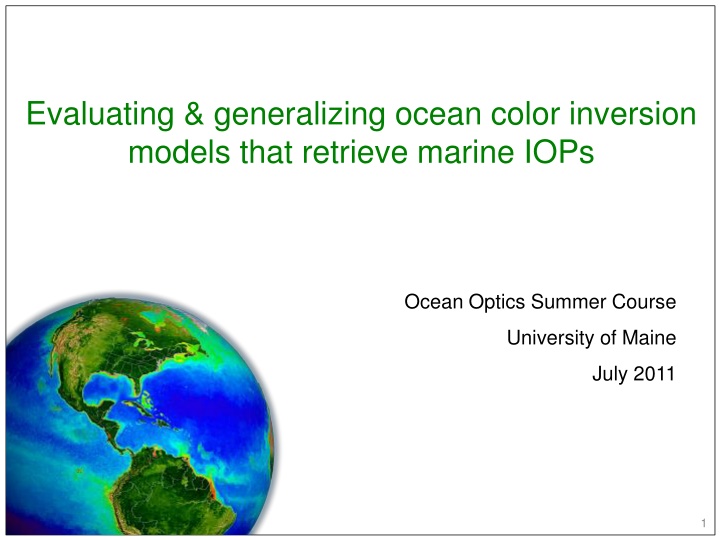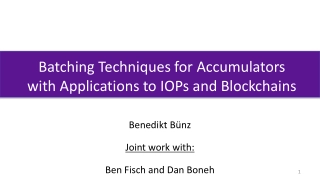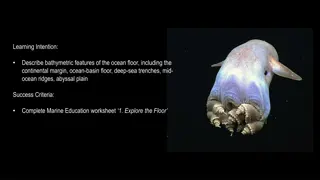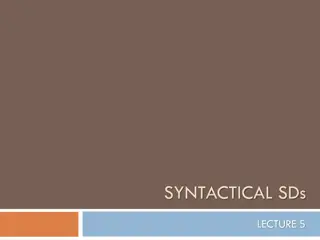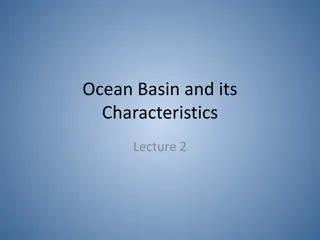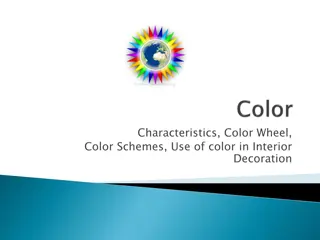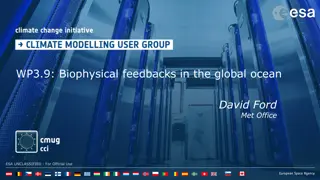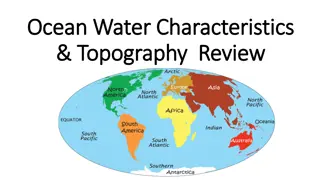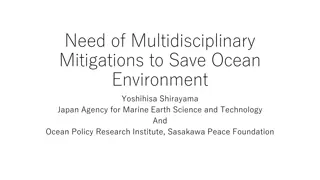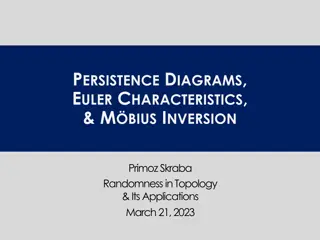Evaluation of Ocean Color Inversion Models for Retrieving Marine IOPs
Evaluating and generalizing ocean color inversion models to retrieve marine inherent optical properties (IOPs) is essential for understanding ocean dynamics. This involves choosing the right algorithm and validating its effectiveness, as discussed in the Ocean Optics Summer Course at the University of Maine in July 2011. The International Ocean Colour Coordinating Group (IOCCG) reports provide valuable insights into the operation and applications of ocean color sensors, satellite missions, ecological provinces partitioning, and atmospheric correction for ocean color products. Recent evaluation activities focus on the construction and deconstruction of semi-analytical IOP algorithms, addressing algorithm validation and sensitivities while considering in-situ and synthetic data sets for algorithm evaluation.
Download Presentation

Please find below an Image/Link to download the presentation.
The content on the website is provided AS IS for your information and personal use only. It may not be sold, licensed, or shared on other websites without obtaining consent from the author.If you encounter any issues during the download, it is possible that the publisher has removed the file from their server.
You are allowed to download the files provided on this website for personal or commercial use, subject to the condition that they are used lawfully. All files are the property of their respective owners.
The content on the website is provided AS IS for your information and personal use only. It may not be sold, licensed, or shared on other websites without obtaining consent from the author.
E N D
Presentation Transcript
Evaluating & generalizing ocean color inversion models that retrieve marine IOPs Ocean Optics Summer Course University of Maine July 2011 1
purpose you re a discriminating customer how do you choose which algorithm (or parameterization) to use? more importantly, how do you validate this choice? 2
outline recent evaluation activities review construction (& deconstruction) of a semi-analytical IOP algorithm introduce a generic approach review emerging questions regarding algorithm validation & sensitivities 3
International Ocean Colour Coordinating Group (IOCCG) http://www.ioccg.org Report 1 (1998): Minimum requirements for an operation ocean colour sensor for the open ocean Report 2 (1999): Status and plans for satellite ocean colour missions: considerations for complementary missions Report 3 (2000): Remote sensing of ocean colour in coastal and other optically complex waters Report 4 (2004): Guide to the creation and use of ocean color Level-3 binned data products Report 6 (2007): Ocean color data merging Report 7 (2008): Why ocean color? The societal benefits of ocean color radiometry Report 8 (2009): Remote sensing in fisheries and aquaculture Report 9 (2009): Partition of the ocean into ecological provinces: role of ocean color radiometry Report 10 (2010): Atmospheric correction for remotely sensed ocean color products 4
IOCCG Report 5 large assemblage of IOP algorithms evaluated using in situ (subset of SeaBASS) and synthetic (Hydrolight) data sets: 3 empirical (statistical) algorithms 1 neural network algorithm 7 semi-analytical algorithms 6
IOCCG Report 5 global distribution of in situ data: synthetic data set (500 stations) represents many possible combinations of optical properties, but not all, and cannot represent all combinations of natural populations: 7
purpose you re a discriminating customer how do you choose which algorithm (or parameterization) to use? more importantly, how do you validate this choice? 9
inversion algorithms operate similarly IOCCG report compared 11 common IOP algorithms but, most of these algorithms are very similar in their design & operation an alternative approach to evaluating inversion algorithms might be at the level of the eigenvector (spectral shape) & statistical inversion method 10
constructing (deconstructing) a semi-analytical algorithm measured by satellite desired products phytoplankton dissolved + non- phytoplankton particles particles 11
constructing (deconstructing) a semi-analytical algorithm eigenvalue (magnitude) eigenvector (shape) 12
constructing (deconstructing) a semi-analytical algorithm N knowns, Rrs( N) User defined: G( N) a*dg( N) a* ( N) b*bp( N) eigenvalue (magnitude) eigenvector (shape) 3 (< N) unknowns, M spectral optimization, deconvolution, inversion 13
constructing (deconstructing) a semi-analytical algorithm most algorithms differ in their eigenvectors & inversion approach significant effort within community over past 30+ years how to choose between algorithms? we (NASA) couldn t decide, so we initiated a series of workshops 14
IOP Algorithm Workshops Ocean Optics XIX (2008, Barga, Italy) & XX (2010, Anchorage, Alaska) 27 participants from Australia, Canada, France, Italy, Japan, UK, & US conceptual goal: achieve community consensus on an effective algorithmic approach for producing global-scale, remotely sensed IOP products practical goal: develop tools, resources, & methods for developing & evaluating global & regional ocean color data products the NASA OBPG developed GIOP a consolidated, community supported, configurable framework for ocean color modeling of IOPs allows construction of different IOP models at run time by selection from a wide assortment of published absorption & scattering eigenvectors http://oceancolor.gsfc.nasa.gov/WIKI/GIOP.html 15
generic IOP algorithm framework power-law, : fixed Lee et al. (2002) Ciotti et al. (1999) Hoge & Lyon (1996) Loisel & Stramski (2001) Morel (2001) tablulated b*bp( ) Lee et al. (2002) fixed bbp( ) [=Mbpb*bp( )] Lee et al. (2002) Loisel & Stramski (2001) other features to be considered: aw and bbw dependence on T and S alternative, tunable a* eigenvectors & methods IOP-based AOP to IOP method(s) Levenberg-Marquardt SVD matrix inversion uncertainties & cost functions tabulated a* ( ) Bricaud et al. (1998) Ciotti & Bricaud (2006) exponential, Sdg: fixed (= 0.0145) Lee et al. (2002) OBPG (2010) tabulated a*dg( ) Morel f/Q Gordon quadratic 16
emerging questions how well does any given configuration perform globally / regionally ? how does one define validate a SAA? how does one define improvement? which data products (a, a , adg, bbp)? what spectral ranges (400-700 nm)? what trophic levels (oligotrophic vs. eutrophic)? spatial coverage vs. accuracy? how sensitive is a GIOP-like SAA to its eigenvectors? 17
emerging questions how well does any given configuration perform globally / regionally ? how does one define validate a SAA? how does one define improvement? which data products (a, a , adg, bbp)? what spectral ranges (400-700 nm)? what trophic levels (oligotrophic vs. eutrophic)? spatial coverage vs. accuracy? how sensitive is a GIOP-like SAA to its eigenvectors? 19
GIOP sensitivity analyses Levenberg-Marquardt SVD matrix inversion inversion method Morel f/Q Gordon quadratic inversion cost function a* Bricaud et al. (1998) a* Bricaud et al. (1998) with Chl +/- 33% a* Ciotti & Bricaud (2006) with Sf=0.5 AOP-IOP relationship, G( ) eigenvectors a*dg exponential, Sdg = 0.0145 a*dg exponential, Sdg default +/- 33% a*dg exponential, Sdg from Lee et al. (2002) number of b*bp power-law, from Lee et al. (2002) b*bp power-law, default +/- 33% 6 (412-670 nm) 5 (412-555 nm) 20
GIOP sensitivity analyses Levenberg-Marquardt SVD matrix inversion hierarchical summary of sensitivities: inversion method tier 1 (very sensitive): Morel f/Q Gordon quadratic Levenberg-Marquardt vs. SVD matrix inversion alternative, fixed a* [Ciotti & Bricaud (2006)] Sdg +/- 33% Morel f/Q vs. Gordon quadratic goodness of fit: input vs. inversion cost function reconstructed Rrs( ) goodness of fit: modeled a* Bricaud et al. (1998) a* Bricaud et al. (1998) with Chl +/- 33% a* Ciotti & Bricaud (2006) with Sf=0.5 6 vs. 5 alternative, dynamic Sdg[Lee et al. (2002)] AOP-IOP relationship, G( ) IOP( ) vs. in situ IOP( ) tier 2 (sensitive in parts of dynamic range): regression statistics eigenvectors population statistics Taylor & Target diagrams a*dg exponential, Sdg = 0.0145 a*dg exponential, Sdg default +/- 33% a*dg exponential, Sdg from Lee et al. (2002) tier 3 (not sensitive): number of b*bp power-law, from Lee et al. (2002) b*bp power-law, default +/- 33% +/- 33% a* from Bricaud et al. (1998) with Chl +/- 33% 6 (412-670 nm) 5 (412-555 nm) 21
Thank you 23
